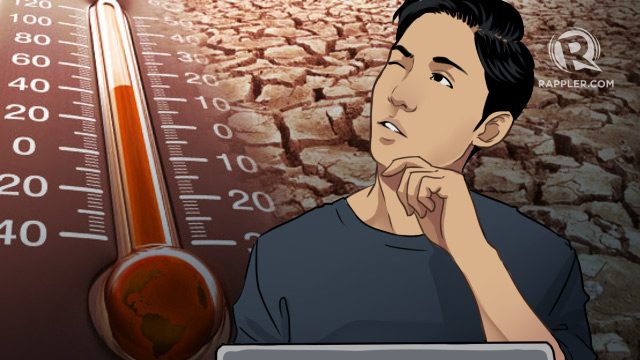SUMMARY
This is AI generated summarization, which may have errors. For context, always refer to the full article.

MANILA, Philippines – Summer is fast approaching in the Philippines and it is expected to be hotter than usual.
State weather bureau PAGASA announced on Wednesday, March 11, the onset of El Niño, causing reduced rainfall and higher temperatures in some parts of the country. (READ: El Niño sets in; PAGASA warns of ‘erratic’ typhoon season)
With El Niño causing a dry spell in the country, farmers, who may find scientific terms difficult to understand, are expected to be most affected by this phenomenon. (READ: How El Niño could affect the Philippines in 2015)
How is government addressing this problem?
On Friday, March 13, MovePH, Rappler’s civic engagement arm, initiated a Facebook conversation dubbed #ZeroCasualty to better understand El Niño, its effects and how the government is preparing for it. (READ: CONVERSATION: #ZeroCasualty Hour: Is PH ready for El Niño?)
Climatologist Anthony Lucero, officer-in-charge of PAGASA’s Climate Monitoring and Prediction Section joined the online conversation.
Community meteorologists?
While PAGASA has been releasing advisories since May 2014, a deeper understanding of El Niño among the public is still needed.
“My impression is that there is not as much education being done to educate people about El Niño as typhoons, earthquakes and other climate events,” Joel Abelinde, one of the netizens following the conversation said.
PAGASA is currently doing the Climate Information Center (CIC), a project that allows the scientific agency and different local government units (LGUs) to work together to better explain scientific information, such as El Niño, to local farmers in communities. This is done with the help of Rice Watch and Action Network (RWAN).
“Remember that we are climatologist[s], we are not agriculturist[s] or farmers or fishermen. We need help from LGUs who know what is happening in their communities. We provide them with our technical info and they are the one[s] customizing our products to suit their own need[s]. We don’t see them but we work in tandem,” Lucero said.
With CICs built in a number of municipalities in the country, Lucero said PAGASA has “trained people to read our information, we also train them how to localize the climate info we pass on to them. So these people are our extensions, they are called the community meteorologist[s],” he added.
Lucero also said through the CICs, communities will receive advisories most appropriate to them. This will be “based on the climate info we provide them,” he added.
He said they require LGUs to have their monitoring systems. “This enables them to follow development of extremes in their community.”
PAGASA also trains the LGUs in using weather instruments.
While the project focuses on agriculture and farmers, Lucero said the Bureau of Fisheries and Aquatic Resources (BFAR) is coordinating with PAGASA to implement this in the fisheries sector.
Preparedness tips
According to Lucero, provinces belonging to Climate Types I and II are the most vulnerable to El Niño.
With expected warmer-than-normal temperatures, this will affect the agricultural, water and power sectors in the country. It may also affect Filipinos, health-wise. He advised the public to:
- Be aware of the ongoing weak El Niño
- Be abreast of the latest developments and advisories that PAGASA will be announcing to the public
- Get in touch with [respective LGUs] for assistance and any help they can provide to the community
– Rappler.com
Add a comment
How does this make you feel?
There are no comments yet. Add your comment to start the conversation.